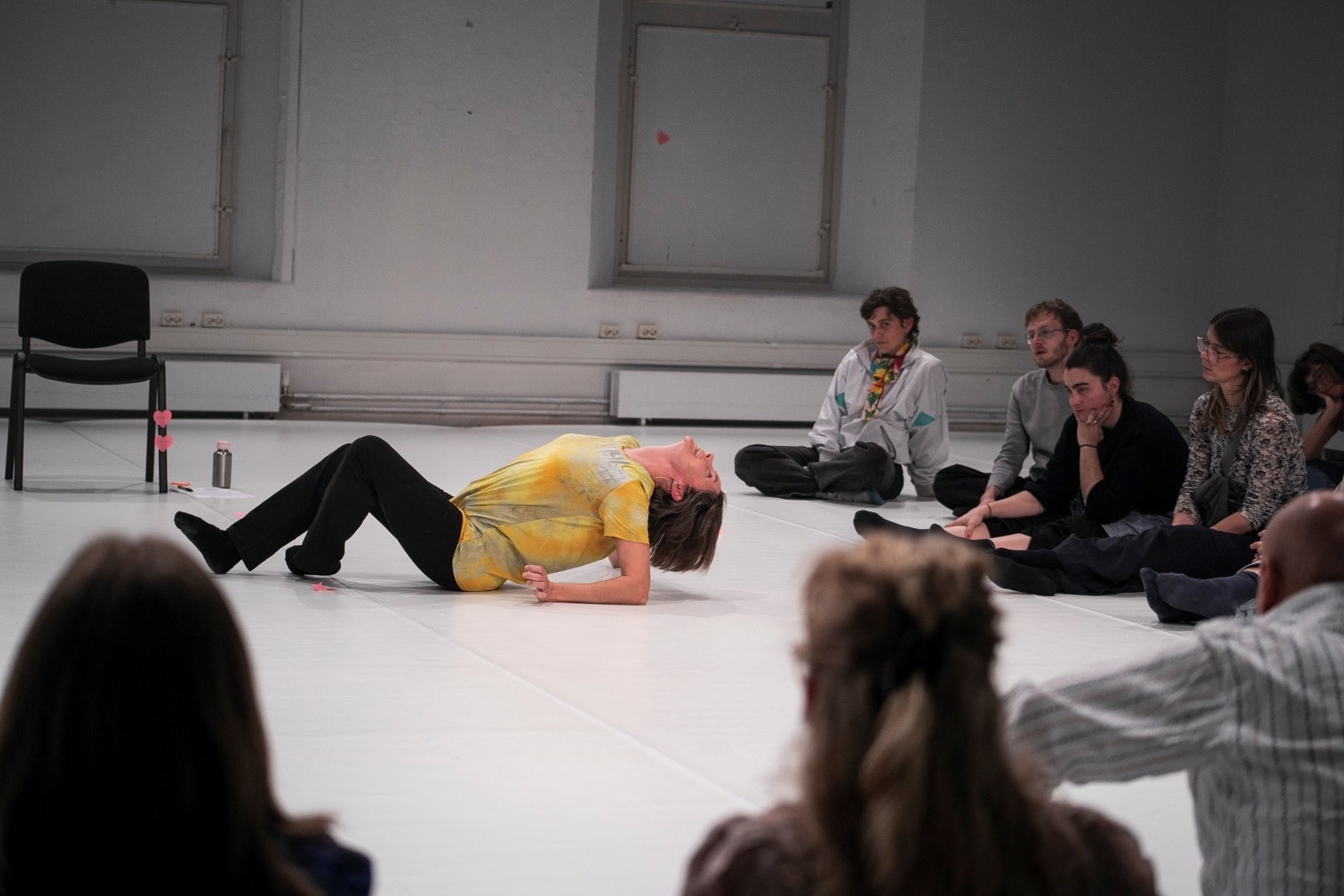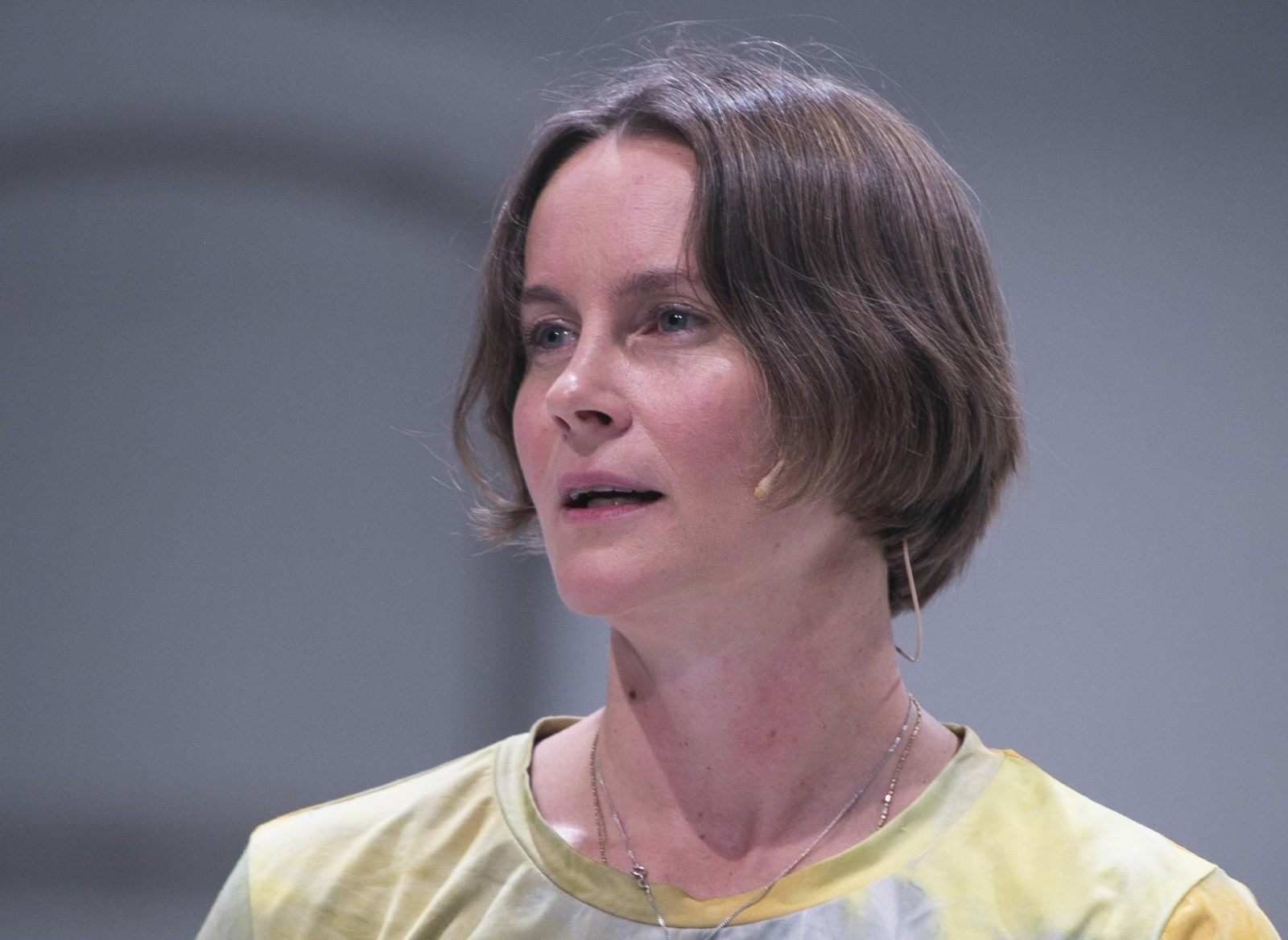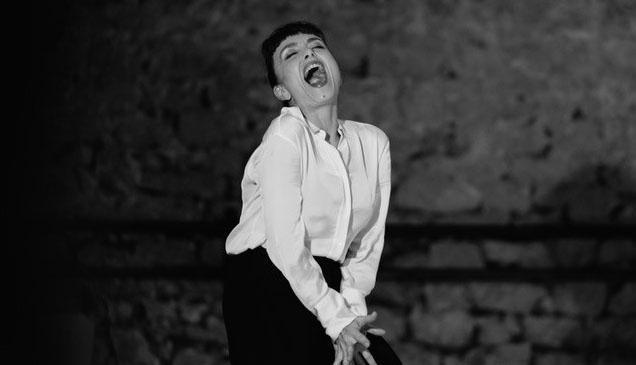Morning classes and warm-up is held by Ido Batash, Vincent Blanc, Lise Fassier, Wanjiru Kamuyu, Noé Soulier and Léa Vinette
Introductions:
Wanjiru Kamuyu
Born in Nairobi and based in Paris since 2007, she began her career in New York, first exploring classical dance before turning toward contemporary forms. As a performer, she has collaborated with renowned choreographers such as Jawole Willa Jo Zollar, Robyn Orlin, Bill T. Jones, Bartabas, and Anne Collod.
As a choreographer, she has partnered with artists including Bintou Dembélé and worked with directors such as Jérôme Savary and Hassan H Kouyaté — with the latter, she developed artistic projects supporting refugees.
Holding a Master of Fine Arts from Temple University (United States), Wanjiru Kamuyu is also deeply engaged in education and the training of dancers worldwide — from Europe to Africa, North America, and Asia — notably through programs at the Alvin Ailey American Dance Theater/Fordham University and the University of South Florida Dance in Paris.
“I commit myself to my artistic sensitivity by highlighting the strengths and possibilities of dance. Dance, as a means of healing, is a platform for self-transformation and expression, going beyond words to reach the depths of the heart and soul. It gives life to our infinite potential, offering an open window onto our fears, our questions, and our hidden desires, buried within our thoughts and spirit.”
Noé Soulier
Born in Paris in 1987, Noé Soulier has developed a distinctive choreographic language nourished by the history of dance, philosophy, and a constant dialogue with other artistic disciplines. Trained at the CNSMD in Paris, the National Ballet School of Canada, and P.A.R.T.S., he also holds a Master’s degree in Philosophy from the Sorbonne. From his earliest works, he has sought to revisit classical, modern, and postmodern legacies in order to construct a language of his own.
His choreographic research is rooted in the exploration of practical goals — striking, avoiding, catching, throwing — which orient the body’s energy. By displacing them toward absent or imaginary objects, he invents a dance in which gestures generate variations in intensity and tension, offering spectators an experience that is both kinesthetic and affective. This approach unfolds in works such as Little Perceptions (2010), Faits et gestes (2016), The Waves (2018) and Close Up (2024).
Alongside this choreographic research, he has developed theoretical inquiry through performances (Mouvement sur mouvement, 2013) and publications (Actions, mouvements et gestes, 2016), aiming to transform the way movement is perceived, overturning hierarchies between body and thought, practice and theory.
Noé Soulier deliberately blurs disciplinary boundaries. In Performing Art (2017), he challenged the traditional relationship between dance and the museum by transforming the installation of a collection into choreography. With Close Up, he entrusted performers with the power to compose their own filmed image, reversing established hierarchies of gaze.
His collaborations with artists such as Tarek Atoui, Thea Djordjadze, and Karl Naegelen extend this desire for porosity across artistic fields. Whether constructing a sculpture live on stage or generating sonic environments, the boundary between choreography, music, and the visual arts becomes porous.
His works have been presented at major venues and international festivals, from Paris to New York, London, Berlin, Tokyo, Taipei, Brussels, and Venice. In parallel, he has choreographed for numerous companies including the Nederlands Dans Theater, the Trisha Brown Dance Company, the Ballet de l’Opéra de Lyon, L.A. Dance Project, and the Ballet de Lorraine.
Since 2020, he has been Director of the CNDC – Angers, a unique institution bringing together a choreographic creation center, a higher education program, and an international dance season. His vision of art as an expansion of the range of our experiences — perceptively, affectively, and politically — informs both his choreographic writing and the project he is developing for this institution.
He is the winner of the Danse Élargie competition (2010), was named Choreographic Personality of the Year by the French Critics’ Association (2024), and received the SACD Choreography Prize (2025).
Vincent Blanc
Vincent Blanc, originally from Gap, began his training at the École Supérieure de Danse de Cannes Rosella Hightower in 1993. With the Jeune Ballet International de Cannes, he worked with choreographers including Monet Robier, Philippe Cohen, and the company Castafiore. In 1999, he joined the Centre Chorégraphique National de Nantes for the creation of Hôtel Central by Claude Brumachon. He remained a performer there until 2011, embodying and transmitting this choreographic language to a wide variety of audiences.
Today, he continues his artistic journey as both dancer and educational director at CCNN. In collaboration with Ambra Senatore, he develops in situ formats that stand at the intersection of artistic creation, pedagogy, and public engagement. His teaching, rooted in imagination and sensation, places strong emphasis on the importance of human connection.
In parallel, he is studying at the French School of Yoga of the West, exploring the synergies between yoga and dance. His practice focuses on how body awareness and breathing can nurture personal development as well as enrich artistic expression.
Ido Batash
Ido Batash is a choreographer and professional dancer based in Ghent. Between 2002 and 2024, he danced and performed for several companies and projects, including: Kabinet K by Joke Laureyns and Kwint Manshoven, les ballets C de la B by Alain Platel, Meytal Blanaru, Inbal Pinto & Avshalom Pollak dance Company, NDD-Itzik Galili Dance, Kibbutz Contemporary Dance Company, Idan Cohen, Talia Back, Roy Assaf and Léa Vinette.
In 2009, Ido began creating his own choreographies, several of which were invited to perform at dance festivals around the world. In addition to his personal artistic activities, Ido initiates independent projects in collaboration with other choreographers, artists and talents from different disciplines and backgrounds. He also teaches dance and movement classes and Fight Love workshops. In 2022, together with Zoë Christiaens, he founded FREEFALL vzw to create a place in Ghent for movement and dance research.
Lise Fassier
After an initial training at the Conservatoire of La Rochelle, Lise became a dancer with Claude Brumachon at the CCN of Nantes in 2001. For fifteen years, she performed some of the choreographer’s most significant works while also leading artistic projects in schools. Her creative, research, and teaching practices have always been grounded in a spirit of dialogue. One project, bringing together children with disabilities and non-disabled children, led her to reconsider how bodies in motion can be perceived and to approach dance as a means of action. This experience inspired her research dissertation The Intention of Gesture, Keystone of an Unlikely Encounter (Certificate of Aptitude, CNSMD of Lyon, 2015).
In 2016, transmission became the heart of her artistic commitment. Lise began working closely with students at Le Pont Supérieur, a higher education institution for the performing arts in the Pays de la Loire region. Alongside Ambra Senatore, she explores play as a creative resource and conceives dance as a space of relationship. She promotes dance through nomadic artistic and pedagogical projects, convinced of the body’s potential in action as a revelation of being in the world.
Most recently, she designed a teaching unit in Arts and Cultural Education for the Department of Arts and Languages at Nantes University.
Léa Vinette
First trained at the conservatory of Nantes, then of Lyon, Lea Vinette then trained in dance and choreography at the ArtEZ art school in the Netherlands from 2013 to 2017. After her studies, Léa worked with various choreographers (Liat Magnezy, Ido Batash, Michèle-Anne de Mey, and Rakesh Sukesh). In 2014, Léa met Florence Augendre and her work in fasciapulsology applied to dance. This practice becomes a real physical and intellectual research, and an important tool in his own creative work. In 2020, Léa follows the training in Charleroi Danse in dance and choreographic practices with in particular Mark Tompkins, Boris Charmatz, Lia Rodrigues, Nora Chipaumire. In 2021, Léa participates in the creation Lilith by Marion Blondeau as a choreographic external gaze.
Léa divides her time between her work as a performer and as a choreographer. Currently, she works as a performer with Louise Vanneste-Rising Horses (earths,METAKUST), Michèle Murray-PLAY (Duos/Collisions and Combustions,Wilder Shores), Tabea Martin (Geh nicht in den Wald, im Wald ist der Wald), Marielle Morales (M-Waves), and the company La Drache (best cantata).
Since 2020, Léa has been developing her work as a choreographer in the territories of Nantes and Brussels. She creates her first piece in November 2022, the solo Nox, at the Nantes CCN in co-production with the Soufflerie. She presented the duo Nos FEUX in March 2024 at the Cndc, where she is an associate artist, as part of the Conversations festival.
Léa combines a visceral and carnal physicality with sensitive writing. It is the raw and brutal nature of man that interests him, his sometimes bubbling energy that agitates and moves him, between emotions and reason. To express this vitality and the beauty of contrasts, she works with electric, alert, and spontaneous bodies.
Léa Vinette’s projects are supported by Météores in delegated production.






